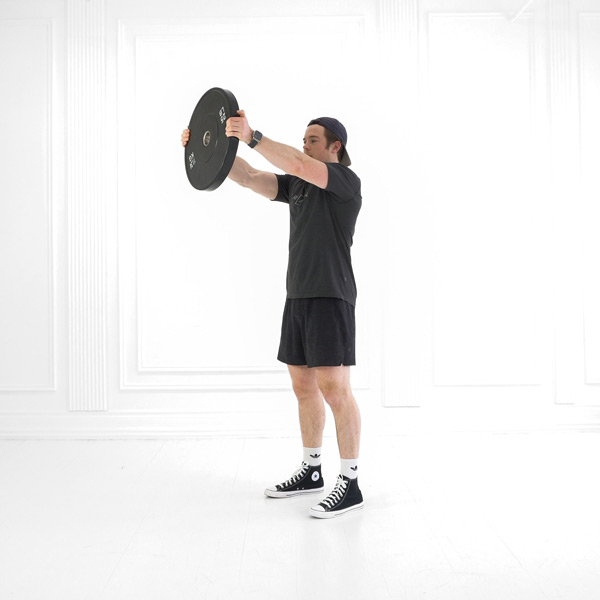Barbell Front Raise
Barbell front raise isolates anterior deltoids to build shoulder strength and definition; lift barbell forward to shoulder height with straight arms.
About Exercise
Equipment
Barbell, Plates
Difficulty
2/5 • Intermediate
Primary Muscle Groups
Shoulders
Secondary Muscles
Chest, Traps
Accessory Muscles
Forearms, Abs, Lower Back
Popularity Score
7
Goals
Training Style
Setup Requirements
Requires Rack
No
Requires Bench
No
Requires Spotter
No
Space Needed
Small
Noise Level
Low
Muscle Breakdown
View Muscle MapShoulders
10/10Anterior Delts
Chest
4/10Upper Chest
Traps
3/10Upper Traps
Forearms
2/10Flexors
Abs
2/10Rectus Abdominis
Lower Back
2/10Erector Spinae
Programming
Typical Rep Range
8-15 reps
Rest Between Sets
60-90 seconds
How to Perform
Stand with feet shoulder-width apart, knees slightly bent. Grip barbell overhand at shoulder width, let it rest against thighs with arms extended and elbows soft.
- Inhale and brace core.
- Lift barbell forward by leading with shoulders, keeping arms straight with slight elbow bend.
- Raise until arms parallel to floor or at eye level.
- Pause briefly at top, squeezing front deltoids.
- Exhale and lower barbell slowly in controlled arc back to thighs.
- Maintain stable torso without swinging.
Coaching Tips
Form Cues
- Lead with shoulders
- Keep core braced
- Elbows slightly bent
- Avoid momentum
- Torso upright
Breathing
Inhale during descent, exhale during ascent while bracing core.
Tempo
3-1-1
Range of Motion
Start with bar at thighs, end with arms parallel to floor; avoid going above eye level to prevent shoulder strain.
Safety
Safety Notes
- Warm up shoulders thoroughly
- Avoid if acute shoulder pain
- Use lighter weight if form breaks
- Do not lock elbows fully
- Stop if lower back discomfort occurs
Spotting
Spotting not typically required; use lighter weight or safeties if pushing limits.
Common Mistakes
- Swinging with back
- Locking elbows
- Leaning backward
- Using excessive weight
- Dropping bar quickly
When to Avoid
- Shoulder impingement
- Acute shoulder injury
- Lower back issues
Flexibility Needed
- Shoulder flexion beyond 90 degrees
- Wrist extension for grip
Build Up First
- Basic shoulder stability
- Core bracing competency
Also known as
Front Barbell Raise, Barbell Shoulder Raise, Overhead Front Raise
Found this helpful?
Share your thoughts or help us improve this guide.
Similar Exercises

Barbell Incline Front Raise
Barbell, Incline Bench
Shoulders

Plate Front Raise

Plates
Shoulders

Barbell Jerk
Barbell, Squat Rack
Quads, Shoulders

Barbell Front Squat

Barbell, Squat Rack
Quads

Barbell Upright Row

Barbell
Shoulders

Barbell Front Rack Lunge
Barbell
Quads

Barbell Overhead Carry
Barbell, Squat Rack
Shoulders

Barbell Overhead Press
Barbell, Squat Rack
Shoulders

Barbell Power Clean and Press
Barbell, Plates
Quads, Glutes

Barbell Seated Shoulder Press

Barbell, Incline Bench
Shoulders


subscribe to our newsletter
Contact Us
hello@trainfitness.aiFind Us
130 Spadina Avenue, Toronto,
Ontario, M5V 0H4, Canada
©2025 All Rights Reserved
